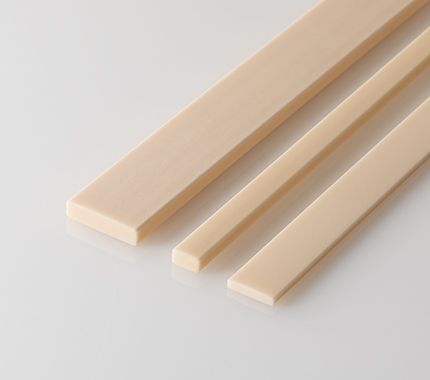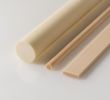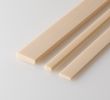Alumina ceramic strips
Ceramic strips are semi-finished products obtained by extrusion. We propose in particular DEGUSSIT AL23 pure alumina strips. Thanks to its electrical, mechanical and thermal properties, aluminium oxide allows these products to be used in high performance fields such as furnace construction or electrical insulation at high temperatures.

The different formats of ceramic strips we offer
In our standard product range, we offer ceramic strips made of Kyocera DEGUSSIT AL23 (99.7% pure alumina). The maximum length of the strip is 400 mm. The price for a fixed length depends on the width and thickness of the ceramic strip. The width of a strip can vary from 1 mm to 16 mm, its length is between 1 mm and 8 mm with always a ratio width / thickness higher or equal to 1.
See the standard catalog products
In addition to pure alumina semi-finished products, we offer strips made of 95% alumina (C795), MACOR®, zirconia or zirconium oxide (8Y-FSZ, 3Y-TZP, Mg-PSZ), dense mullite (C610) or porous mullite (C530), silicon carbide, silicon nitride (Si3N4) or sapphire. This diversity in terms of materials allows us to offer different properties to best suit the requirements of various application areas.
Why choose alumina as a material for the strips?
Alumina is a technical ceramic with many mechanical, electrical and thermal properties and characteristics. Aluminum oxide is a refractory material and is known for its excellent thermal shock resistance at high temperatures: 99.7% pure alumina such as Kyocera DEGUSSIT AL23 can withstand temperatures of up to 1950 °C. The melting temperature of this industrial ceramic is above 2000 °C, which is why it is so heat-resistant and can be used in all high-temperature applications. The purity of our alumina components (e.g. DEGUSSIT AL23) also implies a very good dimensional stability: the homogeneity of the internal structure of the material ensures that it will not be deformed under the effect of heat. Moreover, alumina is an excellent electrical insulator (thanks to its electrical conductivity as low as that of some plastic materials), so it can be used to insulate cables and devices even in conditions involving high temperatures. On the other hand, aluminum oxide offers very good wear resistance, as well as resistance to corrosion and mechanical abrasion, which makes it suitable for components with long operational life.
Among the other materials we offer for our semi-finished products is MACOR®. MACOR® is a glass-ceramic that can withstand temperatures above 1000 °C. It is colorless, odorless and inert, making it the material of choice for medical applications. This material is particularly known and used for its remarkable machinability. Indeed, this glass-ceramic can easily be machined with conventional tools and can be used to make very precise parts with particularly complex geometries. However, the properties of alumina remain superior in most areas: it offers a better resistance to wear, it resists to much higher temperatures; everything depends on the intended use.
How are alumina strips made?
Alumina strips are obtained by extrusion and sintering. By investing in a dedicated extrusion tool, it is possible to extrude all specific geometries and lengths.
For which applications are ceramic strips used?
Alumina ceramic strips are particularly useful in high-temperature applications such as the glass industry or metallurgy: alumina parts can be in contact with the molten material without any problem.
They can also be used in laboratories, for the construction of R&D equipments. Alumina is chemically inert and does not interact with most products, even corrosive ones.






